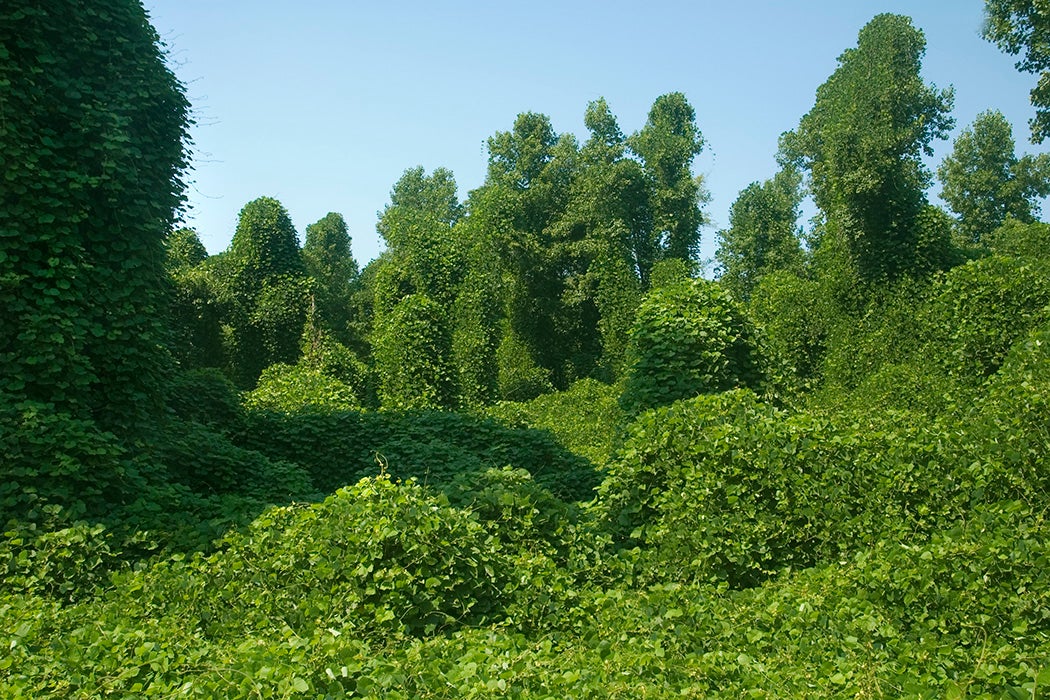It grows so rapidly, it seems like it’s possessed. It swarms across the landscape, resisting all attempts to remove it. And it’s built an outsize reputation to match its outsize growth. According to Derek H. Alderman and Donna G’Segner Alderman, “Perhaps no other part of the natural environment is more closely identified with the South than this invasive and fast growing vine.” They are talking, of course, about kudzu (Pueraria lobata).
“Both southerners and nonsoutherners identify with kudzu as a symbol and incorporate the plant into daily cultural expression, including the language used to characterize and understand social and environmental change,” they write. That “kudzu” has become shorthand for out of control growth throughout the United States demonstrates the South’s influence on the rest of the country.
But the vine came to its Southern identity slowly. Kudzu arrived in the US, like other marvels, via a World’s Fair. Native to Japan, it debuted in North America at the Philadelphia Centennial Exposition in 1876 and was introduced to the South in 1883 at the New Orleans Exposition. Farmers soon showed interest in the plant as an alternative feed for livestock and a means of mitigating erosion. Historian Mart Allen Stewart notes that kudzu was an inexpensive crop as well. It could be grown “without the use of manure or lime, could be easily intercropped with corn, and would provide a feed plant with a protein content 2 percent higher than the highly rated alfalfa hay.”
Perhaps even more important for its spread was its ability to thrive in poor conditions. “It could be grown…on lands with poor soils that would scarcely support other crops,” notes Stewart. Like other legumes, it “replenished nitrogen poor soil. Because it eventually rooted itself deep, it could tap minerals and moisture not available to most plants and, once established, was virtually drought resistant.”
They weren’t wrong about it being an excellent soil stabilizer or about its potential as drought-resistant forage. Kudzu grew in popularity, with the assistance of the government.
“The Soil Conservation Service, empowered with a naïve optimism, established programs to plant kudzu throughout the South, and the agency raised 100 million kudzu seedlings in its nurseries between 1935 and 1942,” write Alderman and Alderman.
Private boosters also got in on the kudzu craze, with the Kudzu Club of America boasting a membership of twenty thousand by 1943. The club’s founder, Channing Cope, was an ardent kudzu fan.
“Cope was instrumental in popularizing the idea that kudzu was a ‘miracle vine’ capable of saving the southern economy and environment,” writes Derek Alderman in a biographical study of the man and plant. Though he describes Cope as a “gentleman farmer,” it’s easy to understand the appeal of kudzu to other Depression-era Southern farmers. A cheap source of feed that would also protect them from soil erosion? One can hardly blame them for getting on board, particularly given kudzu’s seal of approval from the government.
Like other invasive species, kudzu chose to live beyond the boundaries of its promoters’ original goals. Its capacity to spread (and indestructibility) was underestimated. Consequently, its identity has changed over the decades.
“In the 1950s,” Alderman and Alderman write, “the status of kudzu shifted from that of highly valued resource to lowly pest. In fact, by the 1970s, the Department of Agriculture had declared kudzu officially a ‘weed.’”
Unfortunately, kudzu pays no attention to Department of Agriculture declarations. Since its introduction to the US, it has reached twenty-eight of fifty states.
“Even in the harshest of environments, kudzu grows over houses, trees, utility poles, and junkyards. Perhaps most impressive is the ability of kudzu to climb.There are seemingly no limits to what the vine covers or hides,” write Alderman and Alderman.
But its pest status hasn’t stopped it becoming part of Southern identity. The region is dotted with Kudzu Lanes and Kudzu Cafes, a familiarity suggesting affinity with this once localized weed. In a retort to the “Ivy League,” elite Southern Universities are sometimes referred to as the “Kudzu League.”
Indeed, some artists see a beauty where gardeners see a nightmare, and kudzu is metaphorically used to symbolize Southern tenacity. Meanwhile, researchers are trying to derive useful medicinal products from the plant. One study found that kudzu extracts curb the craving for alcohol in Syrian Golden hamsters, leading to hope it could work for humans too. According to Alderman and Alderman, “Herbal stores are presently marketing a Kudzu/St. John’s Wort combination to help treat alcoholism.”
So kudzu may have some more benefits for us yet. We hope.







